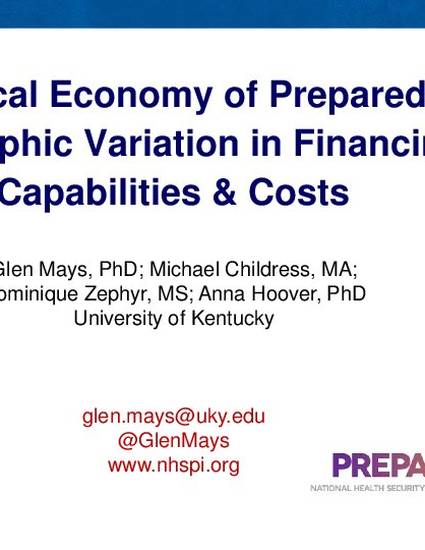
Presentation
The Political Economy of Preparedness: Geographic Variation in Financing, Capabilities and Costs
American Public Health Association Annual Meeting
(2017)
Abstract
OBJECTIVES: Preparedness for health emergencies, outbreaks and disasters varies widely across the U.S., but the causes and consequences of these inequities are poorly understood. This study uses the National Health Security Preparedness Index to examine how financing mechanisms and health insurance coverage influence preparedness across U.S. states. METHODS: The Preparedness Index aggregates data from national household surveys, medical records, safety inspection results, and health agency surveys to produce composite measures of preparedness for each U.S. state and the nation overall. We linked annual Index composite measures for each state and year 2013-16 with contemporaneous measures of federal and state preparedness spending, health insurance coverage, and socioeconomic and demographic characteristics. We use panel regression models to estimate how changes in preparedness spending and insurance coverage influence state preparedness levels, controlling for demographic and socioeconomic factors. RESULTS: State preparedness improved by 6.0% on average during 2013-16, reaching an index score of 6.8 out of 10 in 2016. Preparedness varied twofold across U.S. states in critical domains such as community planning and environmental health. Preparedness increased by 1.8 percentage points for each $10 increase in federal preparedness spending per capita (p<0.01), and by 5.8 percentage points for each 1 point increase in health insurance coverage (p<0.01). Spending on disaster recovery activities declined by $151 per capita for each 1 percentage-point increase in state preparedness levels (p<0.05). CONCLUSIONS: State preparedness is strongly influenced by dedicated federal financing and state successes in health insurance expansion. Stronger preparedness appears to reduce subsequent costs for disaster recovery. Federal policies that reduce support for preparedness planning and health insurance expansion may inadvertently weaken the health system’s ability to protect against large-scale emergencies and outbreaks, resulting in higher recovery costs.
Disciplines
Publication Date
Fall November 7, 2017
Location
Atlanta, GA
Citation Information
Glen P. Mays. "The Political Economy of Preparedness: Geographic Variation in Financing, Capabilities and Costs" American Public Health Association Annual Meeting (2017) Available at: http://works.bepress.com/glen_mays/308/
